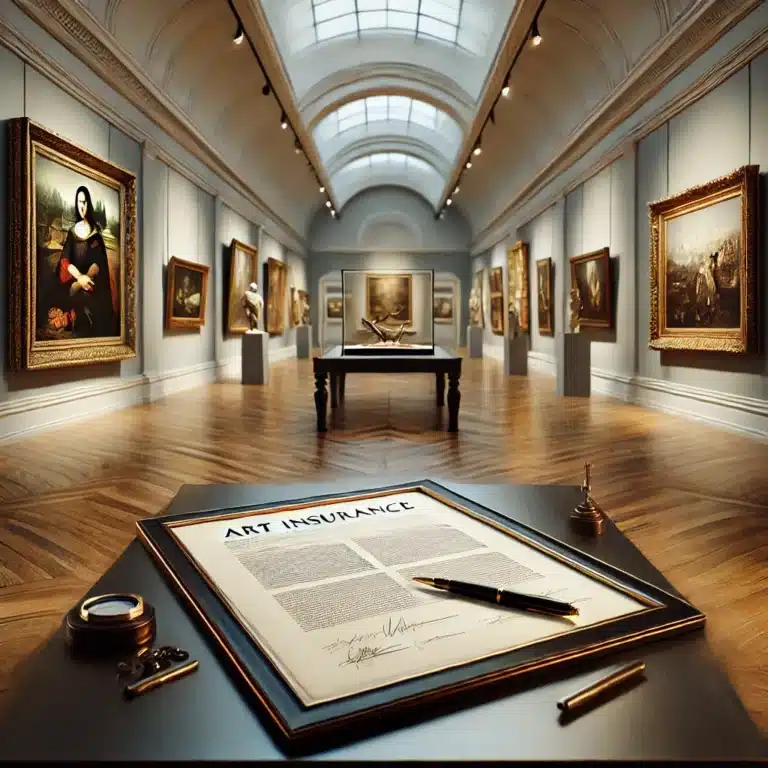Quick Answer: Art Insurance Costs
Art insurance costs 0.1% to 2% of your collection’s value annually. A $500,000 collection typically costs $500-$10,000 per year. Premium factors include location, security, storage conditions, and whether pieces travel for exhibitions.
Art Insurance in 2025: The Complete Guide from Physical Masterpieces to NFTs
Last month, a Houston collector called me in tears. Hurricane flooding had destroyed her $3.2 million art collection – including a Basquiat and two Warhols. The worst part? Her homeowners policy capped art coverage at $25,000 total.
After 20 years helping collectors through Hotaling Insurance Services, I’ve seen this scenario too often. The gap between what people think they have covered and reality can be millions of dollars. Whether you’re protecting a single valuable piece or managing a museum-quality collection, understanding art insurance isn’t optional – it’s essential.
🎨 Key Takeaways
- ✓ Standard homeowners covers only $1,000-$2,500 per artwork
- ✓ Fine art policies cost 0.1%-2% of collection value annually
- ✓ NFT insurance now available but costs 2-5% due to cyber risks
- ✓ Appraisals required only for pieces over $50,000-$250,000
- ✓ “All-risk” policies cover everything except specific exclusions
The Real Cost of Art Insurance (With Actual Examples)
Let’s cut through the confusion with real numbers from policies we’ve placed this year:
| Collection Value | Annual Premium Range | Typical Client Profile |
|---|---|---|
| $100,000 | $100 – $500 | Emerging collector, 5-10 pieces |
| $500,000 | $500 – $2,500 | Serious collector, mixed media |
| $1 Million | $1,000 – $10,000 | Established collection, some blue-chip |
| $5 Million | $5,000 – $50,000 | Museum-quality, frequent exhibitions |
| $10+ Million | $10,000 – $100,000+ | Major collector, global exhibitions |
Real example from our files: A River Oaks client with a $2.8 million collection (including contemporary paintings and sculptures) pays $3,900 annually through Chubb. This includes worldwide coverage, no deductible on most losses, and automatic coverage for new acquisitions up to $700,000 (25% of collection value).
Why Your Homeowners Policy Fails Your Art
Here’s what shocks most collectors when we review their coverage:
- Sublimits kill you: Most homeowners policies cap art at $1,000-$2,500 per piece, with total limits of just 10% of personal property coverage
- Named perils only: Standard policies cover only specific risks like fire or theft – not mysterious disappearance, breakage, or flood damage
- Depreciation stings: Claims settled at “actual cash value” means that $50,000 painting might pay out just $20,000 after depreciation
- Transit excluded: Moving art to storage or exhibitions? Coverage typically stops at your doorstep
We recently helped a client whose $180,000 Chihuly glass sculpture shattered during cleaning. Their homeowners policy? Denied – accidental breakage wasn’t covered. Their new fine art policy would have paid in full with no deductible.
Scheduled vs. Blanket Coverage: Which Strategy Wins?
After placing hundreds of art policies, here’s my honest take on both approaches:
Scheduled Coverage (Itemizing Each Piece)
Best for: Collections under 50 pieces or with significant value disparities
- ✅ Guaranteed payout at agreed value – no haggling during claims
- ✅ Perfect for blue-chip works where value is established
- ❌ Requires constant updates as you buy/sell
- ❌ Can miss newly acquired pieces if not reported promptly
Blanket Coverage (One Limit for Everything)
Best for: Active collectors or collections with many similar-value pieces
- ✅ Automatically covers new purchases
- ✅ Adjusts for market appreciation
- ❌ Requires detailed documentation at claim time
- ❌ May face disputes over current market value
Our recommendation: Hybrid approach. Schedule your top 10-20 pieces representing 70%+ of value, then use blanket coverage for the rest. This balances certainty with flexibility.
The NFT Insurance Revolution (Yes, It’s Real)
The digital art world exploded, and insurance is catching up. Here’s the current NFT insurance landscape:
What’s Actually Available Now
- Coincover: Leading provider offering theft and loss protection up to $1 million per wallet
- Coverage includes: Smart contract failure, cyber theft, fraudulent transfers, private key loss
- Costs: 2-5% annually (higher than physical art due to cyber risks)
- Major gap: Valuation volatility – your $100K NFT could be worth $10K or $1M by claim time
Last week, we consulted with a client holding $2.3 million in CryptoPunks and Bored Apes. Traditional insurers wouldn’t touch it. Through specialized markets, we secured coverage at 3.8% annually – expensive, but essential given the theft risks.
Why Most Insurers Won’t Cover NFTs (Yet)
- No established market history for valuation
- Authentication challenges (proving legitimate ownership)
- Extreme price volatility tied to crypto markets
- Evolving legal framework around digital ownership
⚡ Digital Art Action Plan
If you own NFTs worth over $50,000:
- Get cyber liability coverage first (covers hacking losses)
- Use hardware wallets with multi-signature security
- Document ownership with blockchain verification
- Consider Coincover or similar specialized NFT insurance
- Never rely on marketplace “insurance” – it’s usually just marketing
Real Claims Stories: When Insurance Saves the Day
The $4.2 Million Gallery Fire (Miami, 2024)
A client’s gallery in Wynwood caught fire during Art Basel. Result: 47 pieces destroyed, including commissioned works for collectors. Their specialized gallery policy through AIG paid out $4.2 million within 90 days, including business interruption coverage that kept staff employed during rebuilding.
The Cross-Country Transit Disaster (2023)
During a move from Houston to New York, a truck carrying a collector’s 30-piece contemporary collection crashed. Total loss: $890,000. Because they had “nail-to-nail” coverage through Pure Insurance, every piece was covered at agreed value with no deductible.
The Authentication Nightmare (2024)
A client discovered their $1.5 million “Monet” was fake – after owning it for five years. Their title insurance (a separate policy type) covered the full purchase price plus legal fees, saving them from financial ruin.
The Appraisal Game: What You Really Need to Know
Forget what you’ve heard about needing appraisals for everything. Here’s what major insurers actually require:
- Chubb: Appraisals only for items over $250,000
- AIG Private Client: $100,000 threshold
- Pure Insurance: $50,000 for individual pieces
- Most carriers: Recent purchase receipt acceptable for pieces under threshold
Pro tip: Use AAA (American Appraisers Association) or ASA (American Society of Appraisers) certified appraisers. Cost runs $500-2,500 per piece depending on complexity. Update every 3-5 years or after major market movements.
Insurance by Art Category: Special Considerations
Contemporary Art
- Highest appreciation potential – review values annually
- Artist reputation changes can swing values 500%+
- Consider “pair and set” coverage for series works
Photography
- Edition size critical – 1/3 worth more than 1/100
- Vintage prints vs. later prints = massive value difference
- Digital files need separate backup/recovery planning
Sculptures & Installation Art
- Higher premiums due to fragility and installation risks
- Site-specific works may need separate liability coverage
- Outdoor pieces require weather damage riders
Wine & Rare Books
- Climate control documentation reduces premiums 20-30%
- Provenance even more critical than visual art
- Spoilage and deterioration coverage available
Premium Reduction Strategies That Actually Work
Based on thousands of policies placed, these tactics consistently lower premiums:
- Central station alarm: 10-15% discount with certificate
- Climate control system: 5-10% reduction, especially for works on paper
- Professional storage: Up to 20% savings for high-security facilities
- Higher deductibles: $5,000 deductible can save 25% vs. zero deductible
- Bundle with home/auto: 5-15% through carriers like Chubb or AIG
- Loss-free history: 10% credit after 3 claim-free years
Common Exclusions That Surprise Collectors
Even “all-risk” policies exclude certain losses. Watch for these gaps:
- Gradual deterioration: Fading, warping, or natural aging
- War and nuclear hazard: Standard across all policies
- Inherent vice: Materials naturally breaking down
- Intentional damage: By you or household members
- Confiscation: Government seizure or quarantine
- Pairs and sets: May pay only for damaged piece, not loss in value to set
🎯 Action Checklist for Art Owners
- ☐ Photograph every piece with today’s newspaper for dating
- ☐ Create detailed inventory with purchase receipts
- ☐ Check current homeowners sublimits (usually inadequate)
- ☐ Get appraisals for pieces over $50,000
- ☐ Compare quotes from 3+ fine art specialists
- ☐ Review coverage annually as values change
- ☐ Document condition with periodic photos
- ☐ Maintain climate and security system records
Frequently Asked Questions
Can I insure art I created myself?
Standard fine art policies exclude artist’s own work. You need “artist studio insurance” covering materials, time invested, and market value. We work with Artists Guild policies starting at $500 annually for emerging artists.
What about art in my vacation home?
Most fine art policies include worldwide coverage, but verify the “unoccupied premises” clause. Some carriers require additional security or limit coverage after 60 days vacant. Consider separate scheduling for each location.
How quickly are claims paid?
With proper documentation, partial losses (damage) settle in 30-60 days. Total losses average 60-90 days. Chubb and AIG often provide advances within 2 weeks for established clients. Always photograph damage immediately before cleanup.
Should I insure at purchase price or current value?
Always insure at current replacement value. That piece bought for $10,000 in 2010 might cost $50,000 to replace today. Review values every 2-3 years or after significant market movements.
What if my art appreciates significantly?
Most policies include “inflation guard” of 10-15% annually. For rapid appreciation (common in contemporary art), request a mid-term adjustment. Some carriers offer “agreed value plus” covering up to 150% of scheduled amount.
The Bottom Line: Art insurance isn’t about the premium – it’s about sleeping soundly knowing your collection is protected. After handling claims from hurricane floods to gallery fires, I can tell you: the collectors who thought they’d “save money” with minimal coverage always regret it.
Ready to Protect Your Collection Properly?
Our art insurance specialists work with Chubb, Pure, AIG Private Client, and other premier carriers to design coverage matching your exact needs.
📞 Call 516-344-6900 or request your art insurance review online
About the Author: The Hotaling Insurance Team includes Certified Insurance Counselors specializing in fine art and collectibles coverage. With partnerships including Chubb, AIG Private Client Group, Pure Insurance, and Cincinnati Insurance, we’ve protected over $500 million in art assets across Texas.
Last Updated: September 19, 2025 | Review Date: September 19, 2025
Disclaimer: This article provides general information about art insurance options. Coverage varies by carrier, location, and specific policy terms. Consult with a licensed insurance professional to determine appropriate coverage for your collection.


